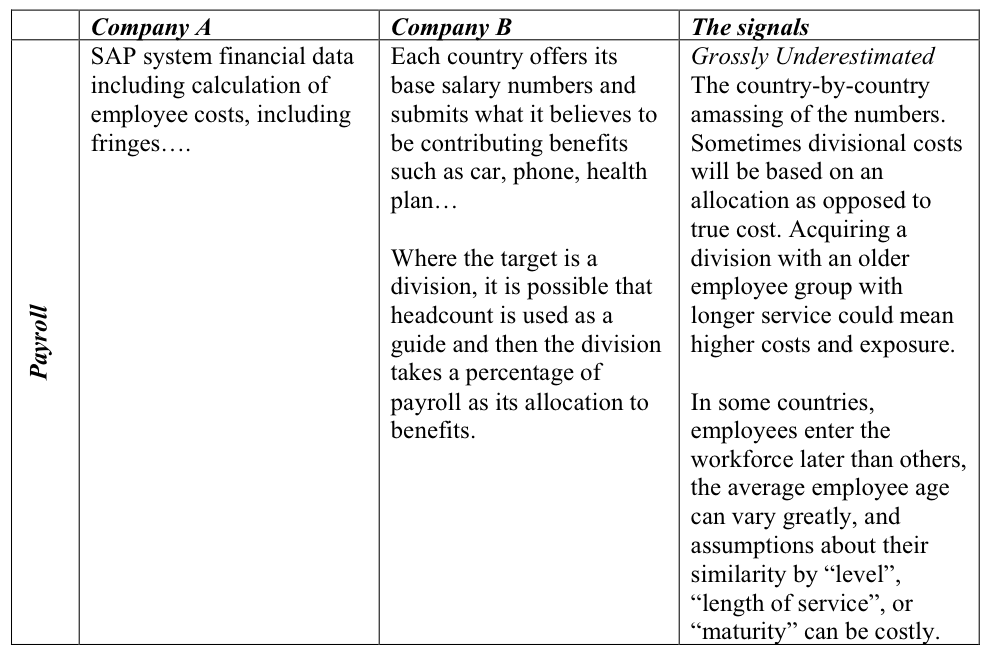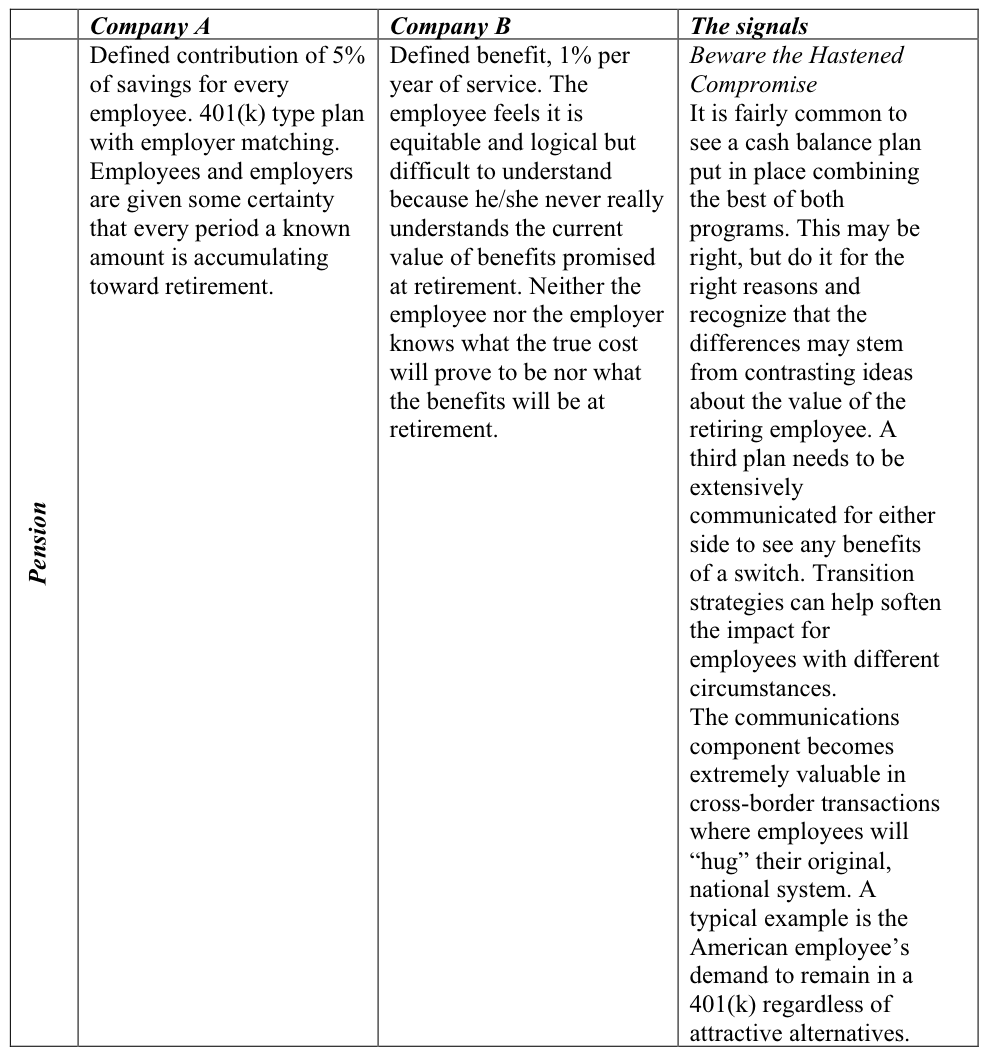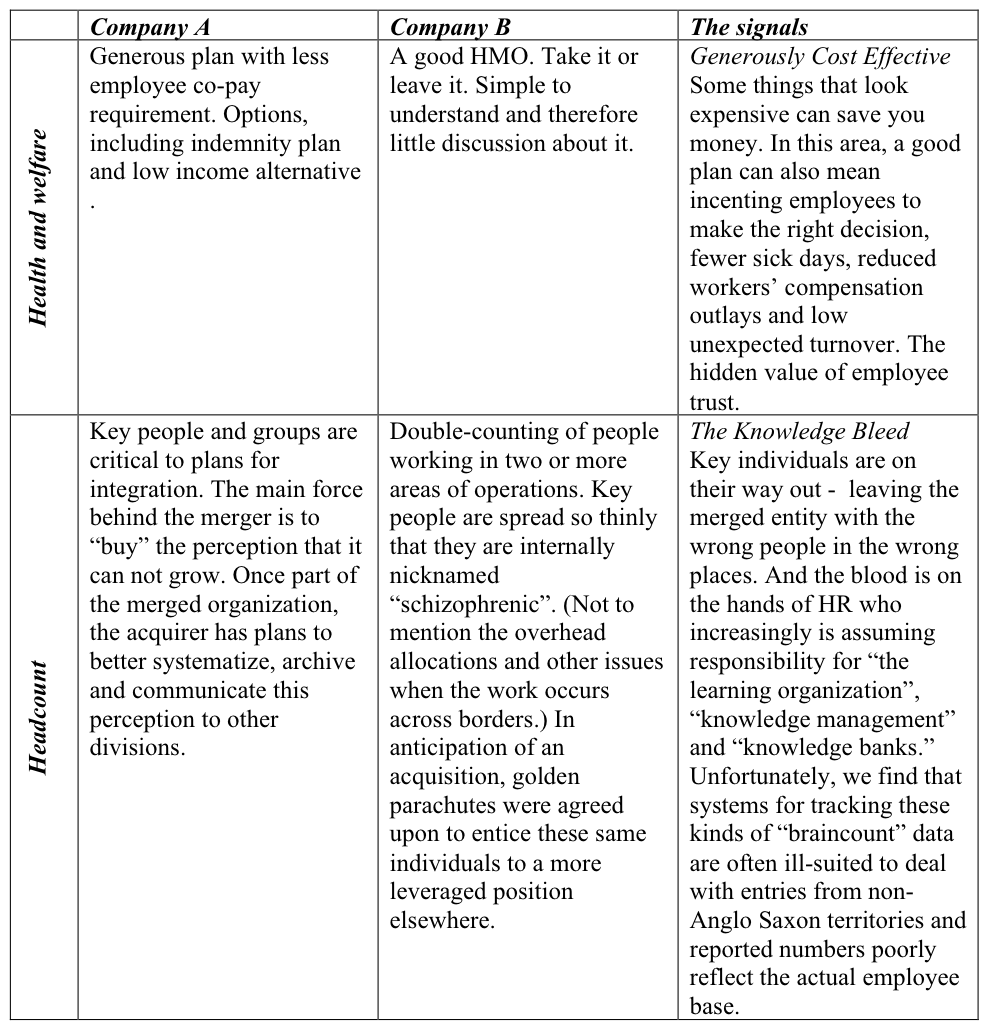
Publications Early Warning Signals Of A Merger (Cultural Integration) Going Awry
- Publications
Early Warning Signals Of A Merger (Cultural Integration) Going Awry

SHARE:
A new role for HR managers in supporting the due diligence
By Karen S. Hinchliffe – PricewaterhouseCoopers
Giving due diligence its due
Amidst the merger mania fostered by competitive pressures, industry dynamics, pursuit of synergy and a relatively benign economy, there is increasing recognition that cultural integration is an important component of merger success.
All too often organizations treat cultural integration as a subset of the actual merger dynamic – as a post-merger consideration. However, there is evidence that early warning signals of potential cultural integration problems can portend problems and offer significant opportunities.
This means that HR may have a more significant role to play during the due diligence related to a merger in compiling and analyzing data, advocating culturally effective approaches and helping other team members interpret the data.
So, HR, pause for a moment in your zealous attempts to gain access to the Board, to present to the Management Team, and to sell upstream to the various change agents overwhelmed with the deal.
Put aside attempts to reengineer the merger process, to plan the details of pre-completion and to audit the ever-so-esoteric. Instead, look at today’s deal-making environment and try to work with that imperfect but real world.

Signs of trouble?
Once a deal has been cut, seemingly “out of nowhere” emerge hidden truths about the actual value of the purchase. Most onlookers point to the senior team as the likely culprits of merger mismanagement. Even the deal-making banks are criticized for their role in value destruction… In the bid to acquire a coveted target, it is easy to overestimate potential and to underestimate costs.
We took a close look at one international deal and did our best to estimate the effects of several reactions to the merger. We have chosen to keep the identities of the merging parties confidential.
In our example, the merging parties were from Europe and the United States. A very few items from a long list yielded a cost that was entirely unanticipated and therefore not included in any contingency ratios. The estimates were even modest and bore a healthy optimism that once identified, the problems would be rectified with the greatest expediency.
Compelling enough? Apparently not. It is unclear whether management teams pay attention to these kinds of issues when they first select an acquisition target. We guess not. And despite the costs of this oversight, the risks do not seem to compel organizations to audit any or all of the following:
• Leader behavior
• Cultural fit
• Employee attitudes and opinion
• Retention and appointment issues
• Manpower target and training issues
• HR department performance
The Due Diligence
Early warning signals can come from the least expected places. A due diligence is often conducted at the outset of the merger, providing ample time to sound the warnings to our deal-makers before post-merger integration difficulties can arise.
The due diligence of a financial deal – where the buyer and seller are looking for immediate financial rationale for merging and have no shared, long-term interest or holdings – provides a limited, but nonetheless a valuable view to the future and early clues as to the long-term viability of the transaction. This kind of due diligence often involves a brief but intense scrutiny of “the numbers”. Nonetheless, the due diligence can point to issues of value to the buyer when the acquisition undergoes restructuring and initial public offering.
The strategic due diligence often provides us with more time and attention to a holistic review of the business. Where there is strategic interest in the transaction, both the buyer and the seller are looking for synergies. Increasingly, strategic and financial deals include a due diligence of several HR areas, such as:
• Executive compensation
• Benefits, including health and welfare plans
• Pensions
• Severance
Even a cursory review of these typical sources of HR cost and value can reveal great variations in the policies of the merging companies. When the policies differ that much they often reflect very different philosophies about the way business is done.
Business strategy reflects our leaders’ vision of how to compete. Consciously or not, leaders send messages to all staff to garner support for their decisions. And they do so very successfully. ”Before you know it,” an elaborate organization is built on a few working assumptions believed to be sacred to the business and its leaders.
A due diligence provides some early warning signals. The target is not always the less advantaged nor does the acquirer always have the more sophisticated HR and financial systems. Suffice it to say there is always one party in the merger who may on any given item of due diligence surprise the other.
A few examples of actual pre-merger, post-selection situations:




Analysis Paralysis
There is so much to analyze in so little time. The management team can easily become paralyzed by the challenge.
The due diligence alone can indicate a few signs of trouble which only grow exponentially worse with every border that is crossed (and every new discrepancy that is encountered):
1. Costs are grossly underestimated.
2. Values are naturally inequitable.
3. Proposed compromises appease no one.
4. Perceived generosities are actually cost savers.
5. Acquired knowledge banks are bleeding.
6. Management systems are recklessly rudderless.
No wonder that culture and other “intangibles” are left unexamined. Isn’t there enough to do?
Solutions beyond Systems
Culture is about behavior. One of the earliest behavioral testing grounds is the management decision-making of merging organizations.
Cultural integration requires some mutual adaptation and therefore changes in behavior and decision-making habits.
In other words, if you took an early close look at leader behavior, you could anticipate potential discontinuities between respective organizations. To examine leader behavior for a cross-border deal, you may need a special kind of expertise: cultural sensitivity.
As several Dutch, French, American, Canadian and Malaysian researchers teach us, there are characteristics of our national and personal identities which are deeply rooted in history and which organizations of those national heritages will espouse. An audit of these issues would look to a comparison of companies with respect to the following:
• Use and importance of the hierarchy and the location of power
• Focus of attention on the individual or the group
• Means of achievement and relationships
• Attitude toward risk and uncertainty
• Consideration of time (past, present, future)
A strong corporate culture can also influence these factors greatly. Organizations often have a view of what is “right” and “wrong” or “good” and “bad” and these values are reflected in any number of written and unwritten rules of behavior:
• Integrity and ethical standards
• Quality customer service
• Learning and development expectations and support systems
• Change, flexibility and stability
• Roles, responsibilities, reporting and decision-making rules
• Teamwork and reward
• Personal performance and reward
• Communication
Sometimes behaviors are encouraged, anticipated and promoted under the banner of a stated corporate value or program, such as: Customer First, Employer of Choice, or Total Quality Management. These programs often work best when they are tailored to a target group of employees or businesses. As a result, many of them do not translate well across even the closest internal borders. When attempted, the implementation of these programs to cultures further afield may be ineffective or even counterproductive.
Early Identification of Opportunity
It would seem that a due diligence uncovers only problems, in the form of costs, clashes and the probability of chaos. But a due diligence carried out with an eye to HR and culture can also result in the early identification of opportunity.
Several questions can reveal opportunity in the form of savings, synergy and the potential for shareholder value, such as:
1. How diverse are the workforces? How are ideas leveraged and transferred?
2. What is the employee mix? How are teams organized and expected to work together?
3. What is done with the results of organizational assessments or employee surveys?
4. How do employees and leadership develop? What kind of feedback do they get?
Refer again to the exhibit of costs incurred through a mismanaged scenario. Imagine for a moment that the same issues were managed more aggressively and with greater savvy about human dynamics and HR systems. Reverse the analysis and make some estimations of value that would be created from the following scenario:
Culture coaches are employed to help facilitate critical meetings. Top management makes progress and gains confidence about the value of the new team. Key people commit to staying through the merger years and begin sharing information about key business processes on which future competitiveness relies. They lock in customers with whom they have strong loyalties. Local differences are taken into account. As a result, some potential works council problems are avoided in Europe and in the U.S. the primary union is included in a transition team, identifying areas for possible negotiation. A communication strategy is agreed that allows for local adaptation and the response is favorable. Employees begin to grasp the reason for the merger and convey their optimism and excitement to the marketplace. Share price rises….
Influencing the go/no go decision
In reality, the due diligence often occurs following a preliminary decision to “go”. Therefore, HR would need to assert its influence on pre-deal process in order to ensure complete attention to human capital and cultural issues.
A reengineered M&A would need to include cultural expertise and coaching in each of the following:
1. Canvassing possible selection targets
2. Identifying a primary and secondary target
3. Defining the integration idea
4. Assessing merger alignments and synergies
5. Designing communication and implementation
6. Managing the various players and projects
This would be the way HR could reduce the M&A failure rate statistics and make a lot of shareholders happy. However, this would require getting HR involved before the ship has left harbor. In today’s world of M&A HR needs to show management that it is paying attention to what happens out at sea.
Where do we go from here?
To sum up, despite the lessons from experience, deals keep evolving which ignore some early signals of distress. Early signals which if heeded and investigated would lead the organization to greater post-merger success! It is your role, HR, to warn them.
Dear CEO,
SOS Save Our Stock. Heed the early warning signals.
Respectfully, Your humble servants The HR Department
Silly, perhaps. However, HR has an obligation to make management aware of (for example): that anticipated savings will not materialize; that the generous new pension plan will burden the acquired entity with too large an overhead contribution and that as a result the team will fail to meet profit projections.
SOS! HR must take action:
1. Prepare the HR team to handle the unexpected crises that may arise: strikes, contract disputes and outstanding liabilities. Plan a communications strategy for the first days of the deal.
2. Articulate the areas of HR most vital to the M&A process. Focus on things that drive value.
3. Break down possible involvement into typical phases of M&A activity: pre-deal closure, transition management and post-transaction implementation.
4. Assess risks inherent in critical human resource areas, including infrastructure. Show balance sheet implications.
5. Estimate potential value to be generated from proactive management of specific HR issues.
6. Get the ear of a management team member. Arm yourselves with data concerning risk and opportunities.
7. Ensure that the external advisors chosen for the due diligence evaluate HR and cultural issues as integral parts of their process.
8. Formulate implications of the merger for a future HR strategy.
9. Get on the due diligence planning and/or review team.
By taking these steps, HR will definitely get the attention of management with issues that will have to be dealt with sooner or later. At the end of the day, HR input might not lead to a change in the ultimate go/no go decision – but then again, it might….


Stay up to date with M&A news!
Subscribe to our newsletter


